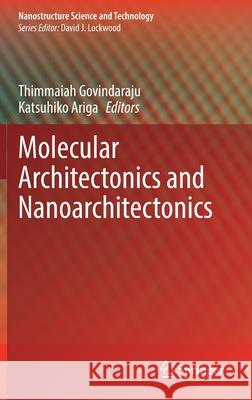Molecular Architectonics and Nanoarchitectonics » książka



Molecular Architectonics and Nanoarchitectonics
ISBN-13: 9789811641886 / Angielski / Twarda / 2021 / 429 str.
Molecular Architectonics and Nanoarchitectonics
ISBN-13: 9789811641886 / Angielski / Twarda / 2021 / 429 str.
(netto: 651,74 VAT: 5%)
Najniższa cena z 30 dni: 655,41
ok. 22 dni roboczych
Dostawa w 2026 r.
Darmowa dostawa!
Book title: Molecular Architectonics and Nanoarchitectonics
Series title: Nanostructure Science and Technology
Contents
Preface/Introduction: Molecular architectonics to nanoarchitectonics
(Thimmaiah Govindaraju and Katsuhiko Ariga)
Part 1 Molecular Architectonics and Nanoarchitectonics
1. Molecular architectonics. Thimmaiah Govindaraju, Bioorganic Chemistry Laboratory, New Chemistry Unit and the School of Advanced Materials (SAMat), Jawaharlal Nehru Centre for Advanced Scientific Research, Jakkur P.O., Bengaluru 560064, Karnataka, India. Email: tgraju@jncasr.ac.in
2. Nanoarchitectonics. Katsuhiko Ariga, International Center for Materials Nanoarchitectonics (WPI-MANA), National Institute for Materials Science (NIMS), 1-1 Namiki, Ibaraki, Tsukuba 305-0044, Japan. E-mail: ARIGA.Katsuhiko@nims.go.jp
Part 2. Architectonics of functional molecules
3. Topological Supramolecular Polymer. Shiki Yagai, Institute for Global Prominent Research (IGPR), Chiba University, 1-33 Yayoi-cho, Inage-ku, Chiba, 263-8522, Japan. Email: yagai@faculty.chiba-u.jp
- Molecular architectonics guide the fabrication of self-cleaning materials. Thimmaiah Govindaraju, Bioorganic Chemistry Laboratory, New Chemistry Unit and School of Advanced Materials (SAMat), Jawaharlal Nehru Centre for Advanced Scientific Research, Jakkur P.O., Bengaluru 560064, Karnataka, India. Email: tgraju@jncasr.ac.in
Part 3. Architectonics of peptides
6. Dopamine-based materials: recent advances in synthesis methods and applications. Junbai Li, Beijing National Laboratory for Molecular Sciences (BNLMS), Key Laboratory of Colloid and interfaces and Chemical Thermodynamics, Institute of Chemistry, Chinese Academy of Sciences, jbli@iccas.ac.cn
7. Peptide-based nanoarchitectonics: Self-assembly and biological applications. Xuehai Yan, State Key Laboratory of Biochemical Engineering, Institute of Process Engineering (IPE), Chinese Academy of Sciences (CAS), China. Email: yanxh@ipe.ac.cn
8. Peptide cross-b nanoarchitectures: characterizing self-Assembly mechanisms, structure and physicochemical properties. Bradley L. Nilsson, Department of Chemistry, University of Rochester, 120 Trustee Road, Rochester, NY 14627-0216, Email: bradley.nilsson@rochester.edu
9. Function-inspired design of molecular hydrogels: Paradigm shifting biomaterials for biomedical applications. Praveen Kumar Vemula, Institute for Stem Cell Biology and Regenerative Medicine (inStem), UAS-GKVK Campus, Bellary Road, Bangalore 560065, Email: praveenv@instem.res.in
10. Smart peptide assembly architectures to mimic biology’s adaptive properties and applications. Debasish Haldar, Department of Chemical Sciences, Indian Institute of Science Education & Research Kolkata, Mohanpur, Nadia - 741246, India. Email: deba_h76@iiserkol.ac.in
Part 4. Architectonics of nucleic acids
11. Bio-inspired functional DNA architectures. Eugen Stulz, University of Southampton, University Road, Southampton, SO17 1BJ, United Kingdom. Email: est@soton.ac.uk
- Functional molecule templated DNA molecular architectonics. Thimmaiah Govindaraju, Bioorganic Chemistry Laboratory, New Chemistry Unit and School of Advanced Materials (SAMat), Jawaharlal Nehru Centre for Advanced Scientific Research, Jakkur P.O., Bengaluru 560064, Karnataka, India. Email: tgraju@jncasr.ac.in
13. Architectures of nucleolipid assemblies and their applications. S. G. Srivatsan, Department of Chemistry, Indian Institute of Science Education and Research (IISER), Pune, Dr. Homi Bhabha Road, Pashan, Pune 411008, India. E-mail: srivatsan@iiserpune.ac.in
14. Nucleobase and DNA functionalized hydrogels and their applications. Apurba K Das, Department of Chemistry #220, Helium Building, Indian Institute of Technology Indore, Email: apurba.das@iiti.ac.in
15. RNA nanoarchitectures and their applications. Ashwani Sharma, Indian Institute of Science Education and Research (IISER) Tirupati, India. Email: a.sharma@iisertirupati.ac.in
Part 5. Architectonics of complex systems and advanced objects
16. Covalent organic frameworks as tunable supports for HER, OER and ORR catalysts- a new addition to heterogeneous electrocatalysts. Ramanathan Vaidhyanathan, Department of Chemistry, Indian Institute of Science Education and Research Pune, Pashan, Maharashtra, India. E-mail: vaidhya@iiserpune.ac.in
17. Ligand functionalised nanostructures and their biomedical applications. Nikhil Ranjan Jana, School of Materials Science, Indian Association for the Cultivation of Science, I2A & 2B Raja S C Mullick Road Kolkata 700032, INDIA.
18. Biomimetic composite materials and their biological applications. Rawil Fakhrullin, Kazan Federal University, Institute of Fundamental Medicine and Biology, Kazan, Russian Federation. Email: kazanbio@gmail.com
19. Combining polymers, nanomaterials, and biomolecules: Nanostructured films with functional properties and applications. Osvaldo Novais de Oliveira Junior, Institute of Physics, Universidade de São Paulo (USP), São Carlos - São Paulo - Brazil. Email: chu@ifsc.usp.br
20. Responsive polymeric architectures and their biomaterial applications, Mitsuhiro Ebara, International Center for Materials Nanoarchitectonics (WPI-MANA), National Institute for Materials Science (NIMS), 1-1 Namiki Tsukuba, Ibaraki 305-0044 Japan, Email: EBARA.Mitsuhiro@nims.go.jp
Dr. Thimmaiah Govindaraju is a professor at JNCASR, Bengaluru, India. He received his M.Sc in chemistry (2000) from Bangalore University and Ph.D. (2005) from the National Chemical Laboratory and University of Pune, Pune, India. He carried out postdoctoral research at the University of Wisconsin-Madison, USA (2005–2006) and the Max Planck Institute of Molecular Physiology, Dortmund, Germany (2006–2008). His research interests are at the interface of chemistry, biology, and biomaterials science, and include molecular architectonics, nanoarchitectonics, silk-inspired biomaterials, upcycling cyclic dipeptides, diagnostic therapy and Alzheimer’s disease. He has published more than 120 papers, several book chapters, and 4 books, and holds more than 10 patents.
This book is the ultimate assembly of recent research activities on molecular architectonics and nanoarchitectonics by authors who are worldwide experts. The book proposes new ways of creating functional materials at the nano level using the concepts of molecular architectonics and nanoarchitectonics, which are expected to be the next-generation approaches beyond conventional nanotechnology. All the contents are categorized by types of materials, organic materials, biomaterials, and nanomaterials. For that reason, non-specialists including graduate and undergraduate students can start reading the book from any points they would like. Cutting-edge trends in nanotechnology and material sciences are easily visible in the contents of the book, which is highly useful for both students and experimental materials scientists.
1997-2025 DolnySlask.com Agencja Internetowa
KrainaKsiazek.PL - Księgarnia Internetowa









